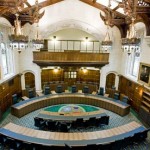Share it
 Last Friday some of the UKSC Blog editorial team attended “The UK Supreme Court: An assessment of the first three years”, a conference hosted by the Centre for Commercial Law Studies at Queen Mary, University of London. This post will concentrate on the afternoon’s lectures on the Supreme Court as a constitutional entity.
Last Friday some of the UKSC Blog editorial team attended “The UK Supreme Court: An assessment of the first three years”, a conference hosted by the Centre for Commercial Law Studies at Queen Mary, University of London. This post will concentrate on the afternoon’s lectures on the Supreme Court as a constitutional entity.
Paul Craig, a public law specialist and Professor in Law at the University of Oxford, gave a presentation on Supreme Courts, constitutional justice and political theory. He highlighted challenges faced by the UKSC (and the House of Lords) that were analogous to those faced by other Supreme Courts in the wake of 9/11 – that is, how the interaction between courts and legislature in the recent past has revealed tensions through attempts to place curbs on the ordinary application of due process. In analysing AF [2009] UKHL 28, a House of Lords case handed down shortly before the UKSC was established, Craig spoke of the panel’s balancing act between national security concerns and the HRA 1998 in finding that persons subject to control orders must have sufficient access to information held about them to give effective instructions in their defence. He described this as the Court finding that there was an inner core of natural justice that could not be overridden by necessity.
Craig went on to describe the progress of the jurisprudence through Tariq [2011] UKSC 34, where the UKSC determined the limits of the decision in AF, to Al Rawi [2011] UKSC 35, where the majority decided that closed material procedures could only be introduced by statute – a statement that the Court was not prepared to use its inherent power to regulate its processes to introduce fetters on the principle of natural justice. Craig finished by putting this in the context of the Justice and Security Bill – proposed legislation he sees as the result of government dissatisfaction with the outcomes of these cases that would narrow judicial discretion considerably.
James Lee, a lecturer at the University of Birmingham law school and an authority on judicial reasoning, spoke on “Precedent and the Supreme Court”. He has recently published a book on the subject – From House of Lords to Supreme Court, which reflects upon the jurisprudence of the House of Lords and considers the prospects for judging in the Supreme Court. At the conference Lee considered the UKSC’s treatment of its previous decisions as well as those from the House of Lords. By focusing on horizontal stare decisis he evaluated the UKSC’s suitability as an instrument for law reform, and considered whether the doctrine of precedent has been diminished in the new Court.
The four UKSC cases where direct reference has been made to the Practice Statement (on judicial precedent) were analysed. In Austin v Southwark [2010] UKSC 28 Lord Hope stated that the Supreme Court had not thought it necessary to re-issue the Practice Statement, as it had as much effect in the new Court as it did in the House of Lords. This was significant as the UKSC was not specifically required to adopt the same practices as the Lords. Although Lady Hale was critical of the relevant precedent in this matter, it was not expressly departed from – the appeal was allowed on an alternative ground, described by Lee as an “escape route”. The analysis of Jones v Kaney [2011] UKSC 13 considered whether or not there was a body of authority to depart from, taking into account obiter comments in Lords’ cases and authorities from lower courts. It considered the problems with “bootstraps” reasoning, where obiter or dissenting comments are relied upon as authority. Another problem Lee identified was where relevant authorities are departed from without being expressly overruled – as in Jones v Kernott [2011] UKSC 53. In R (KM) v Cambridgeshire County Council [2012] UKSC 23 Lee described the possibility of the recurrence of “bootstraps” reasoning. The opportunity to use a dissenting opinion from a very recent UKSC authority had presented itself, but this turned out to be a false alarm as that particular point of law was not engaged in the appeal. Lee concluded that these differences in approach to precedent should be avoided for coherent development of the common law.


